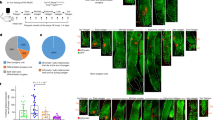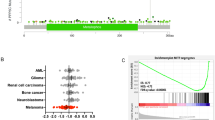Abstract
Most stem cells are not totipotent. Instead, they are partially committed but remain undifferentiated. Upon appropriate stimulation they are capable of regenerating mature cell types1. Little is known about the genetic programmes that maintain the undifferentiated phenotype of lineage-restricted stem cells. Here we describe the molecular details of a nodal point in adult melanocyte stem cell differentiation in which Pax3 simultaneously functions to initiate a melanogenic cascade while acting downstream to prevent terminal differentiation. Pax3 activates expression of Mitf, a transcription factor critical for melanogenesis2,3, while at the same time it competes with Mitf for occupancy of an enhancer required for expression of dopachrome tautomerase, an enzyme that functions in melanin synthesis4. Pax3-expressing melanoblasts are thus committed but undifferentiated until Pax3-mediated repression is relieved by activated β-catenin. Thus, a stem cell transcription factor can both determine cell fate and simultaneously maintain an undifferentiated state, leaving a cell poised to differentiate in response to external stimuli.
This is a preview of subscription content, access via your institution
Access options
Subscribe to this journal
Receive 51 print issues and online access
$199.00 per year
only $3.90 per issue
Buy this article
- Purchase on Springer Link
- Instant access to full article PDF
Prices may be subject to local taxes which are calculated during checkout




Similar content being viewed by others
References
Fuchs, E., Tumbar, T. & Guasch, G. Socializing with the neighbors: stem cells and their niche. Cell 116, 769–778 (2004)
Potterf, S. B., Furumura, M., Dunn, K. J., Arnheiter, H. & Pavan, W. J. Transcription factor hierarchy in Waardenburg syndrome: regulation of MITF expression by SOX10 and PAX3. Hum. Genet. 107, 1–6 (2000)
Watanabe, A., Takeda, K., Ploplis, B. & Tachibana, M. Epistatic relationship between Waardenburg syndrome genes MITF and PAX3. Nature Genet. 18, 283–286 (1998)
Yasumoto, K. et al. Microphthalmia-associated transcription factor interacts with LEF-1, a mediator of Wnt signaling. EMBO J. 21, 2703–2714 (2002)
Steel, K. P., Davidson, D. R. & Jackson, I. J. TRP-2/DT, a new early melanoblast marker, shows that steel growth factor (c-kit ligand) is a survival factor. Development 115, 1111–1119 (1992)
Tsukamoto, K., Jackson, I. J., Urabe, K., Montague, P. M. & Hearing, V. J. A second tyrosinase-related protein, TRP-2, is a melanogenic enzyme termed DOPAchrome tautomerase. EMBO J. 11, 519–526 (1992)
Nishimura, E. K. et al. Dominant role of the niche in melanocyte stem-cell fate determination. Nature 416, 854–860 (2002)
Widlund, H. R. & Fisher, D. E. Microphthalamia-associated transcription factor: a critical regulator of pigment cell development and survival. Oncogene 22, 3035–3041 (2003)
Kuhlbrodt, K., Herbarth, B., Sock, E., Hermans-Borgmeyer, I. & Wegner, M. Sox10, a novel transcriptional modulator in glial cells. J. Neurosci. 18, 237–250 (1998)
Bondurand, N. et al. Interaction among SOX10, PAX3 and MITF, three genes altered in Waardenburg syndrome. Hum. Mol. Genet. 9, 1907–1917 (2000)
Bertolotto, C. et al. Microphthalmia gene product as a signal transducer in cAMP-induced differentiation of melanocytes. J. Cell Biol. 142, 827–835 (1998)
Aksan, I. & Goding, C. R. Targeting the microphthalmia basic helix-loop-helix-leucine zipper transcription factor to a subset of E-box elements in vitro and in vivo . Mol. Cell. Biol. 18, 6930–6938 (1998)
Jin, Z. X. et al. Lymphoid enhancer-binding factor-1 binds and activates the recombination-activating gene-2 promoter together with c-Myb and Pax-5 in immature B cells. J. Immunol. 169, 3783–3792 (2002)
Eberhard, D., Jimenez, G., Heavey, B. & Busslinger, M. Transcriptional repression by Pax5 (BSAP) through interaction with corepressors of the Groucho family. EMBO J. 19, 2292–2303 (2000)
Cai, Y., Brophy, P. D., Levitan, I., Stifani, S. & Dressler, G. R. Groucho suppresses Pax2 transactivation by inhibition of JNK-mediated phosphorylation. EMBO J. 22, 5522–5529 (2003)
Roose, J. et al. The Xenopus Wnt effector XTcf-3 interacts with Groucho-related transcriptional repressors. Nature 395, 608–612 (1998)
Behrens, J. et al. Functional interaction of beta-catenin with the transcription factor LEF-1. Nature 382, 638–642 (1996)
DasGupta, R. & Fuchs, E. Multiple roles for activated LEF/TCF transcription complexes during hair follicle development and differentiation. Development 126, 4557–4568 (1999)
Chu, E. Y. et al. Canonical WNT signaling promotes mammary placode development and is essential for initiation of mammary gland morphogenesis. Development 131, 4819–4829 (2004)
Andl, T., Reddy, S. T., Gaddapara, T. & Millar, S. E. WNT signals are required for the initiation of hair follicle development. Dev. Cell 2, 643–653 (2002)
Ikeya, M., Lee, S. M., Johnson, J. E., McMahon, A. P. & Takada, S. Wnt signalling required for expansion of neural crest and CNS progenitors. Nature 389, 966–970 (1997)
Lee, H. Y. et al. Instructive role of Wnt/beta-catenin in sensory fate specification in neural crest stem cells. Science 303, 1020–1023 (2004)
Garcia-Castro, M. I., Marcelle, C. & Bronner-Fraser, M. Ectodermal Wnt function as a neural crest inducer. Science 297, 848–851 (2002)
Huelsken, J., Vogel, R., Erdmann, B., Cotsarelis, G. & Birchmeier, W. Beta-catenin controls hair follicle morphogenesis and stem cell differentiation in the skin. Cell 105, 533–545 (2001)
Hari, L. et al. Lineage-specific requirements of beta-catenin in neural crest development. J. Cell Biol. 159, 867–880 (2002)
Brault, V. et al. Inactivation of the beta-catenin gene by Wnt1-Cre-mediated deletion results in dramatic brain malformation and failure of craniofacial development. Development 128, 1253–1264 (2001)
Kim, J., Lo, L., Dormand, E. & Anderson, D. J. SOX10 maintains multipotency and inhibits neuronal differentiation of neural crest stem cells. Neuron 38, 17–31 (2003)
Ashery-Padan, R. & Gruss, P. Pax6 lights-up the way for eye development. Curr. Opin. Cell Biol. 13, 706–714 (2001)
Marquardt, T. et al. Pax6 is required for the multipotent state of retinal progenitor cells. Cell 105, 43–55 (2001)
Nutt, S. L., Heavey, B., Rolink, A. G. & Busslinger, M. Commitment to the B-lymphoid lineage depends on the transcription factor Pax5. Nature 401, 556–562 (1999)
Acknowledgements
We thank A. Glick for K5-rtTA mice, M. Shin and E. Morrisey for mice and scientific advice, and T. Andl, A. Souabni, C. Lobe, W. Birchmeier, G. Oliver, T. Force and P. Hamel for reagents. This work was supported by grants from the NIH to S.E.M. and J.A.E.
Author information
Authors and Affiliations
Corresponding author
Ethics declarations
Competing interests
The authors declare that they have no competing financial interests.
Supplementary information
Supplementary Methods
Detailed experimental methods and references. (DOC 43 kb)
Supplementary Figure S1
Additional data regarding the regulation of DCT by Pax3, Sox10 and MITF. (GIF 101 kb)
Rights and permissions
About this article
Cite this article
Lang, D., Lu, M., Huang, L. et al. Pax3 functions at a nodal point in melanocyte stem cell differentiation. Nature 433, 884–887 (2005). https://doi.org/10.1038/nature03292
Received:
Accepted:
Issue Date:
DOI: https://doi.org/10.1038/nature03292
This article is cited by
-
Irradiation-induced hair graying in mice: an experimental model to evaluate the effectiveness of interventions targeting oxidative stress, DNA damage prevention, and cellular senescence
GeroScience (2024)
-
Thy1 marks a distinct population of slow-cycling stem cells in the mouse epidermis
Nature Communications (2022)
-
The evolving view of thermogenic adipocytes — ontogeny, niche and function
Nature Reviews Endocrinology (2021)
-
Vascular smooth muscle-derived Trpv1+ progenitors are a source of cold-induced thermogenic adipocytes
Nature Metabolism (2021)
-
Detection and prognostic role of heterogeneous populations of melanoma circulating tumour cells
British Journal of Cancer (2020)
Comments
By submitting a comment you agree to abide by our Terms and Community Guidelines. If you find something abusive or that does not comply with our terms or guidelines please flag it as inappropriate.



